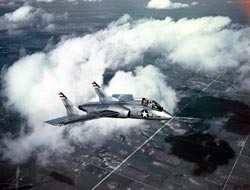|
|||||||
|
As the engine-afterburner design progressed, the J46 engine thrust was established as 6,000 pounds at full military thrust with afterburner. As noted previously, the engine development was delayed to the extent that the first 16 F7U-3 airplanes were required to be a special design using the Allison J35-A-29 engines without afterburner. When the Westinghouse J46-WE-8 engines with afterburner were available for installation in the Number 17 and subsequent F7U-3 airplanes, the military thrust had been downrated to 5,800 pounds with afterburner and 3960 pounds without afterburner to extend engine life. The resultant lowered thrust would plague the F7U-3 program throughout its service life by making the airplane somewhat sluggish to thrust changes in carrier landing conditions
|

 In 1948/49, Chance Vought proposed the F7U-3 to the U. S. Navy. To support this airplane, an engine contract was awarded to Westinghouse for a much more powerful jet engine (the J46-WE-8 engine). The early thrust projections for this engine were 6,000-pound dry thrust, 9,000 pounds with afterburner. The airplane design was for a larger, faster, more rugged version of the F7U configuration using these more powerful engines with integral afterburners.
In 1948/49, Chance Vought proposed the F7U-3 to the U. S. Navy. To support this airplane, an engine contract was awarded to Westinghouse for a much more powerful jet engine (the J46-WE-8 engine). The early thrust projections for this engine were 6,000-pound dry thrust, 9,000 pounds with afterburner. The airplane design was for a larger, faster, more rugged version of the F7U configuration using these more powerful engines with integral afterburners.